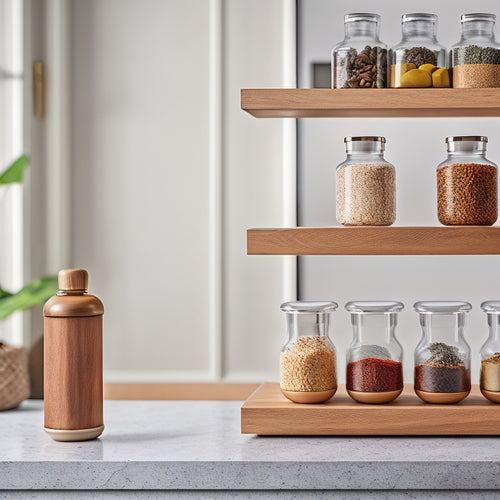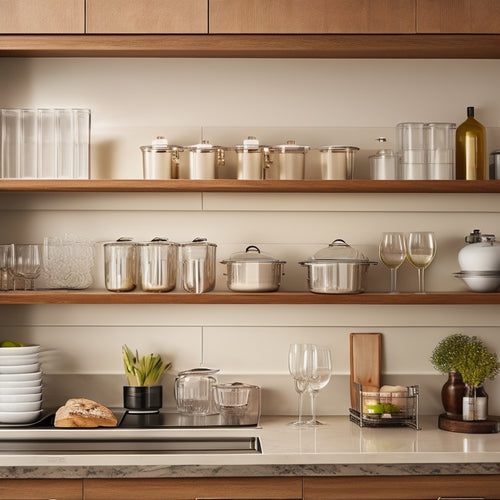
10 Essential Meal Planning Tips for Weight Loss
Share
To reach your weight loss goals, you need a solid meal planning strategy. Start by setting specific, achievable, and measurable goals that align with your lifestyle and health status. Then, plan your meals around weekly sales to save money and incorporate healthy ingredients. Prep in advance to save time and reduce stress, and cook proteins in bulk safely to guarantee a steady supply of healthy meals. Don't forget to stay hydrated with infused water and control portion sizes to manage calorie intake. By following these essential meal planning tips, you'll be well on your way to achieving your weight loss goals, and there's more to discover to secure your long-term success.
Key Takeaways
• Establish specific, achievable, and measurable weight loss goals that align with your lifestyle and health status.
• Plan meals around weekly sales to create a budget-friendly meal plan that incorporates discounted seasonal produce and economical non-perishable items.
• Keep a well-stocked pantry and fridge with healthy ingredients, including fresh produce, lean proteins, whole grains, and healthy fats, to make healthy choices easier.
• Dedicate time on weekends or a specific day for meal prep to save time, reduce stress, and increase organization throughout the week.
• Incorporate infused water into your diet by mixing fruits, herbs, or vegetables with water to stay hydrated and reap the health benefits of your chosen ingredients.
Set Realistic Weight Loss Goals
Before delving into meal planning, set specific, achievable, and measurable weight loss goals that align with your lifestyle and health status, so you can create a tailored plan that suits your needs. This will help you stay focused and motivated on your weight loss journey. When setting your goals, consider your overall health, fitness level, and any dietary restrictions you may have. Aim to lose 1-2 pounds per week for a sustainable weight loss.
In addition to setting weight loss goals, prioritize mindful eating habits. Pay attention to your hunger and fullness cues, eat slowly, and savor your food. This will help you develop a healthier relationship with food and reduce overeating.
Regular physical activity is also essential for weight loss. Establish an exercise routine that you enjoy, whether it's walking, jogging, or weightlifting. Aim for at least 150 minutes of moderate-intensity exercise per week.
Plan Your Meals Around Sales
By planning your meals around weekly sales, you can create a budget-friendly meal plan that not only saves you money but also encourages you to try new recipes and ingredients. This approach allows you to take advantage of discounted prices on seasonal produce, which isn't only cost-effective but also guarantees you're getting the freshest ingredients.
Check the weekly ads for your local grocery stores and plan your meals around the items on sale. You can also stock up on non-perishable items when they're at their most economical. This will help you create a meal plan that's both healthy and affordable.
Look for budget-friendly recipes that incorporate the sale items, and get creative with your meal prep. You can also consider meal prepping on the weekends when you have more time, and reheating meals throughout the week.
Keep Healthy Ingredients on Hand
You'll find it easier to stick to your meal plan and weight loss goals if you keep a well-supplied pantry and fridge with healthy ingredients that can be mixed and matched to create a variety of nutritious meals. Having a constant supply of fresh produce, lean proteins, whole grains, and healthy fats will ensure you're always prepared to whip up a healthy meal.
When you have the right ingredients on hand, you'll be more likely to make healthy choices and avoid last-minute takeout or fast food.
In addition to keeping a well-supplied pantry, make sure you have the essentials for meal prep, such as containers, ziplock bags, and a slow cooker. This will allow you to prep healthy meals in advance, saving you time and energy during the week.
Prep in Advance to Save Time
Time management is essential when it comes to meal planning, and prepping in advance is a game-changer for saving hours during the week. By dedicating a few hours on the weekend or one day a week to prep, you'll set yourself up for success and reduce the likelihood of relying on takeout or fast food.
Here are some benefits of prepping in advance:
| Benefits | Description |
|---|---|
| Saves Time | Reduces daily meal prep time, allowing for more free time |
| Reduces Stress | Knowing you have healthy meals ready to go can reduce stress and anxiety |
| Increases Organization | Helps you stay on track with your meal plan and grocery list |
Cook Proteins in Bulk Safely
Once you've got your meal prep schedule in place, it's time to think about cooking proteins in bulk, a strategy that can be a huge time-saver as long as you follow safe food handling practices.
When cooking proteins in bulk, it's crucial to prioritize proper storage to prevent contamination and foodborne illness. Make sure to cool your cooked proteins quickly and store them in airtight containers within two hours of cooking. Label each container with the date and contents, and keep them refrigerated at 40°F (4°C) or below.
When it comes to meal prep techniques, consider portioning your cooked proteins into individual servings to make meal assembly a breeze. You can also freeze cooked proteins for up to three months, making them easy to thaw and use in future meals. Just be sure to freeze them in airtight containers or freezer bags to prevent freezer burn.
Make a Grocery List Stick
To ensure a smooth and efficient meal prep process, create a grocery list that accurately reflects your dietary needs and stick to it by avoiding impulse buys and staying organized. This will help you stay on track with your weight loss goals and save time and money in the long run.
Here are some tips to help you make your grocery list stick:
-
Set a budget and allocate it to different grocery categories to avoid overspending
-
Plan your meals around what's in season and on sale to make the most of your budget
-
Keep a running list of staples like rice, quinoa, and canned goods to make sure you never run out
- Consider shopping online or using a meal kit service to streamline your grocery shopping and meal prep process
Avoid Last-Minute Takeout Temptation
By sticking to your grocery list and meal prep plan, you've set yourself up for success, but the real challenge begins when you're tired, stressed, or just plain hungry, and the temptation to order last-minute takeout starts to creep in. This is when you need to dig deep and remind yourself why you started meal planning in the first place - to make healthy choices and reach your weight loss goals.
To avoid giving in to temptation, prepare for these moments by having healthy options readily available. Keep a stash of pre-cut veggies, lean proteins, and whole grains in your fridge and pantry.
This way, when you're feeling hungry and tired, you can whip up a quick and easy meal that aligns with your goals. Remember, meal prep isn't just about cooking meals in advance, but also about having the right ingredients on hand to make healthy choices.
Incorporate Veggies Into Every Meal
You'll turbocharge your weight loss journey by making veggies the star of every meal, as they're packed with fiber, vitamins, and antioxidants that support a healthy metabolism. By incorporating a variety of veggies into your meals, you'll not only feel fuller longer but also provide your body with the essential nutrients it needs to function at its peak.
Imagine your plate filled with:
- Roasted sweet potatoes and Brussels sprouts alongside grilled chicken
- Sauteed spinach and bell peppers mixed with quinoa and black beans
- Steamed broccoli and carrots served with a side of brown rice and lean turkey
- Grilled asparagus and zucchini wrapped in a whole-grain tortilla with hummus and avocado
Get creative with your veggie combinations to avoid monotony and optimize you're getting a range of nutrients. Experiment with different cooking methods, seasonings, and pairings to find your favorite ways to enjoy veggies.
Use a "First In, First Out" Rule
Now that you've mastered the art of veggie-packed meals, it's time to tackle meal planning logistics, starting with a simple yet effective rule: use the oldest ingredients first to minimize food waste and save money. This 'first in, first out' approach guarantees that fresh produce doesn't spoil before you get a chance to use it. It's also essential for pantry organization, as it helps you keep track of what you have and what needs to be consumed first.
| Benefits | Actions |
|---|---|
| Reduce food waste | Check expiration dates and consume oldest items first |
| Save money | Plan meals around ingredients nearing expiration |
| Increase meal efficiency | Organize pantry and fridge by expiration date |
| Improve fresh produce usage | Store fresh produce in visible areas for easy access |
| Simplify meal planning | Create a 'use by' calendar for ingredients |
Stay Hydrated With Infused Water
Drinking enough water is crucial for weight loss, and infusing it with fruits, herbs, or vegetables can make this essential habit more enjoyable and nutritious. You'll not only stay hydrated but also reap the health benefits of your chosen ingredients.
Here are some invigorating flavor combinations to try:
-
Strawberry and mint for a sweet and cooling twist
-
Lemon and ginger for a zesty and energizing drink
-
Cucumber and lime for a light and rejuvenating infusion
- Berries and basil for a fruity and aromatic treat
Frequently Asked Questions
How Many Meals Should I Plan per Week for Weight Loss?
When planning meals for weight loss, you should aim to create a weekly grocery list that covers 4-5 meals per day, allowing for flexibility and portion control, to guarantee you're fueling your body without overdoing it.
Can I Meal Plan if I Have Dietary Restrictions or Allergies?
Imagine solving a puzzle with missing pieces - that's meal planning with dietary restrictions or allergies. You can still succeed by substituting ingredients and exploring allergy-friendly recipes, ensuring every meal is a perfect fit for your unique needs.
Will Meal Planning Take up Too Much of My Time?
You're worried that meal planning will consume too much of your time, but with efficient time management and meal prep, you can whip up quick recipes, saving you hours in the long run.
How Do I Stay Motivated With Meal Planning for Weight Loss?
"You thought you'd be a meal planning rockstar, but now you're stuck in a rut. Don't worry, you're not alone! Stay motivated with meal prep accountability buddies and find endless recipe inspiration through online support groups."
Can I Still Eat Out Occasionally While Meal Planning for Weight Loss?
You can still eat out occasionally while meal planning for weight loss by developing smart eating strategies, opting for healthier dining options, and making informed choices, even at fast food joints, to support your goals.
Related Posts
-

Under-Sink Storage Tips for Minimalist Kitchens
To maximize under-sink storage in your minimalist kitchen, start by utilizing vertical space with shelf risers and st...
-

Modern Countertop Spice Organizer Designs
Modern countertop spice organizer designs enhance your kitchen's aesthetics while maximizing functionality. These spa...
-

Pull-Out Cabinet Shelves for Dish Drainer Storage
Pull-out cabinet shelves are a revolutionary innovation for your dish drainer storage. They maximize vertical space a...


